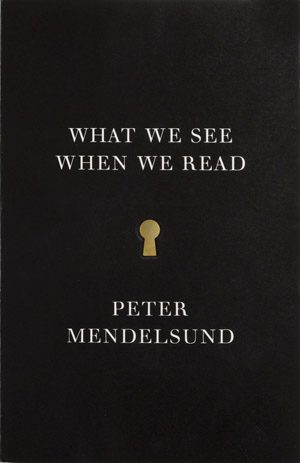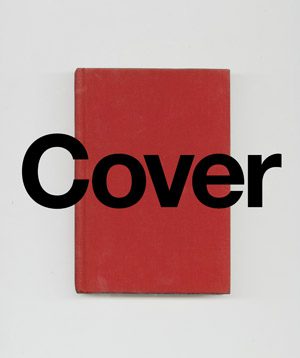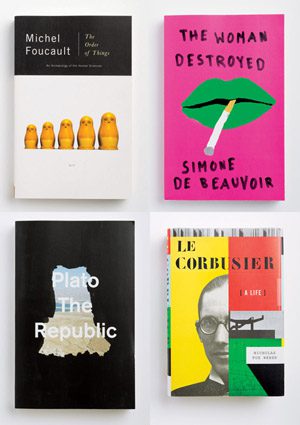You can, if you are so inclined, easily find someone to tell you how design is important because the product is important. There are magazines, blogs, and podcasts dedicated to convincing you that it’s okay to fetishize your Macbook—at least until a newer one comes along. Knopf art director and book cover designer Peter Mendelsund, however, is not that guy. What Mendelsund cares about is text. If Jeff Bezos devours print and book jackets go away but people still read long narratives on e-readers, Mendelsund will tell you that civilization will soldier on.
He didn’t come to this realization easily or from some point of false humility. He came to it by thinking hard about the work he does. Peter Mendelsund wants you to know that he’s not some mindless drone with a color wheel and a copy of Photoshop. But if the man himself won’t convince you that design matters, his work will. Peter Mendelsund is astonishingly good at what he does.
The creator of iconic covers for titles such as The Flame Alphabet, The Enchanted Wanderer, and of course, The Girl with the Dragon Tattoo, Mendelsund recently published two books of his own. What We See When We Read is a deconstruction of the visual experience of reading, a heady mixture of philosophy and neuropsychology. Mendelsund seeks to understand how we perceive narratives and in particular how we envision them. “The story of reading is a remembered story,” he writes.
When we read, we are immersed. And the more we are immersed, the less we are able, in the moment, to bring our analytic minds to bear upon the experience in which we are absorbed. Thus, when we discuss the feeling of reading we are really talking about the memory of having read.
Cover, on the other hand, is book firmly rooted in the tangible world of his past work. It’s a hybrid, part monograph, part manifesto. Interspersed between samples of Mendelsund’s best covers are essays by Mendelsund and authors he’s worked with about what good design can do and how the process of creating book jackets can improve.
***
The Rumpus: You have these two books out at once, and they’re completely different. Did that worry you at all?
Peter Mendelsund: In a way, I really wanted them to be more different. Now that the writing is over, I can look back and see that there’s this interesting kind of speaking to each other. The way I mentally formulated it is, Here’s What We See When We Read, and the other is What I Saw When I Read. Those are twins in a weird sort of way. One’s more visual, and the other’s more verbal.
Rumpus: One of the core assertions of What We See When We Read is that the memory of reading is a false memory, that the remembered continuity is something your brain fills in after the fact. As we’re reading we don’t experience it as a series of gaps. It’s experienced more like a film where it seems continuous. I was wondering how you came to that realization.
Mendelsund: I think we would come to a similar conclusion about any experience we had if we really after the fact examined our feelings in detail. I don’t think this is specific to reading. It’s probably true to some extent of optical seeing too—that the brain is designed to make a seamless narrative of any experience that we have and that any of these experiences is made up of disjointed pieces because we’re not quite able to get every piece of information that’s available to us foregrounded at the same time. We take pieces of things, and we put them together into a coherent whole.  So I knew that was the case about life in general, and I know how binocular vision works, and you sort of convolve these two views of the world, and all of these views are constructs.
So I knew that was the case about life in general, and I know how binocular vision works, and you sort of convolve these two views of the world, and all of these views are constructs.
The moment where it happened was after having this conversation with a friend of mine about his experience putting his biographical details into his imagination in terms of how he was viewing books. When I then started examining the reading experience, then all of the sudden I was reading with this meta-awareness, and once I started to apply that meta-awareness, when I kept part of myself in reserve while I was reading a book, then these things started to open up to me.
Rumpus: When I’m reading, even as I’m reading, I don’t experience it as a series of flashes of detail. What, when you read, fills those gaps? And if it’s true that you’re going through this process of filling in the gaps without being aware of it, is there any way to come to a consensus about the meaning of a text?
Mendelsund: These questions are hard because it depends on what you mean by mean. You’d have to come up with a really good epistemological theory of the world. I guess the short answer would be, “I don’t know.”
I would say that to experience a book is to experience a structure, and to experience that structure is to be carried from one point in the structure to the next. That structure is built out of narrative. The words themselves can be specifically evocative, but they don’t need to be. They can simply be the thing that propels you. Syntax and grammar and sentences and paragraphs can just be there in order to propel you through a book. And you can feel all kinds of things when you’re being propelled through a book. Some of them are specific to the text you’re reading, and some of them aren’t. So the answer to that question also depends on who you are, what you’re reading, what the circumstances under which the reading is taking place, and the kind of prose you’re reading. There’s some prose that will demand of you a certain degree of attention, and there will be a certain amount of detail given that will demand that your imagination stay somewhat tethered—or more so than some other books where there’s less physical description and more narrative drive. But it’s very difficult to say what is actually happening and who owns what in terms of meaning without trying to describe how we’re cognitive beings in the universe, which is something I’m not capable of doing.
All I can say is that the narrative of reading is nothing more than a narrative. It seems to not be true. It’s only true insomuch as we believe that we’re seeing something in the filmic sense and the optical sense. Whether believing something is as good as doing it, I’m not capable of answering that question. It leads to a kind of regression. If I were to go back and rewrite the book, I would probably change that sentence that uses the word false because I don’t think there’s a true sense of what reading is in the same way I don’t think there’s a true explanation of what consciousness is. I would just say, rather than false, that it’s a metaphor that works but isn’t powerful enough to describe or index all of the experiences we have while reading.
I did a talk at Columbia, and in it I did two readings. From What We See When We Read, it was the passage about imagination and memory and how much we bring of our own material to the table. Then the passage I read from Cover was a little footnote from the Lolita piece that’s about consensus-driven covers and what I call the Cover Design Test, which is that meaning isn’t as wishy-washy as we think. Generally, you can come to some sort of consensus over the meaning of a particular text. So all I was doing there was adumbrating the outlines of the two extremes,, that the book isn’t entirely open and then the alternate view that the book is the author’s. The truth is somewhere in the middle,  and it’s highly contextual. When you’re making a book jacket, you’re not really describing the book in a way that’s conclusive. You’re simply giving one reading of it that might be abstract and open enough so that other people can find their readings in it.
and it’s highly contextual. When you’re making a book jacket, you’re not really describing the book in a way that’s conclusive. You’re simply giving one reading of it that might be abstract and open enough so that other people can find their readings in it.
Rumpus: What We When We Read is all in Times New Roman—as were the covers for The Information and The Flame Alphabet—which seems to me a very deliberate choice. It’s such an uncharacteristic font for a designer.
Mendelsund: Yeah, super deliberate. I had this hysterical tweet I got the other day. He was clearly a designer and had bought the Vintage book and was like, “Nobody told me that What We See When We Read was set in Times. I’ll never trust again!” It was just someone utterly broken by the fact.
One of the things I’m interested in is what if your building blocks are really prosaic. I know that it’s possible to geek out on typefaces, and I do on occasion. More and more these days I’m interested in sort of wonky older faces, but I just went through a long phase where it’s like the Vignelli thing: What if it’s all Helvetica? Part of that is just poking a stick at stuff.
Rumpus: It seems, because it’s so common, to get out of the way of the ideas.
Mendelsund: That’s right. There’s a neutrality to it. On a cover, you can only balance so many ideas at one time, and sometimes that’s type and image. Sometimes it’s three typefaces and an image, and you start loading things on. Before you know it, it can’t sustain the weight of all of those things. So I tend to feel like, Is this an image-driven cover or is this a typographically driven cover? If it’s an image-driven cover, you still have to convey the information in the right hierarchy, but if it can recede visually, that’s a good thing. Part of that is getting the type out of the way. You know most book cover designers would love to work without type at all. If we could just put an image on a cover, done, that would be great. And maybe that’s how it will be in the future with of digital production because the letters on a cover on Amazon are entirely redundant. There’s no reason it couldn’t be an icon. The same information is repeated right next to the cover at the point of purchase. My point is that let’s make the typeface so vanilla that it’s not an extra thought you have to have. You can concentrate on what’s viscerally important.
There was this other thing: What We See When We Read was designed very quickly. It’s very much not designed in many ways just because of the publishing schedule and the writing of it was such an insane half a year that it wasn’t like I could sit down and work out all of the rags and everything. There was no time for that. My first idea and probably the only design conceit was that this is going to be like The Medium is the Massage, the Marshall McLuhan book. It’s all black and white. It’s like a zine, and it’s all set in Helvetica and, I think, Times also. It has a really nice aesthetic, and it was a really important book, culturally in its moment. I thought, I’m going to do the same thing here, and there was all this Helvetica, and then slowly I got rid of the Helvetica. You think these things are so intentionally, but sometimes things just happen.
Rumpus: In the introduction to Cover, Tom McCarthy said that your designs show what isn’t there, and that seemed to me to be what What We See When We Read was about, what we don’t see. But what, in the end, do we see?
Mendelsund: The term itself, see, and interrogation of that word is what What We See When We Read is about. It’s about the ways in which we use the word see. So in the ocular sense, even that is a mystery, and then there’s the phenomenological sense, the awareness of seeing. There are all kinds of ways in which we see things. All seeing is mediated on some level. So that’s sort of the point of What We See When We Read.  And then there’s that you’re trying to adumbrate the outlines so you get a piece of something and you try to extrapolate the whole. Or you get the shadowy outline of something, and from that you extrapolate what’s inside the outline. All of those ways of seeing are about how we build something out of nothing.
And then there’s that you’re trying to adumbrate the outlines so you get a piece of something and you try to extrapolate the whole. Or you get the shadowy outline of something, and from that you extrapolate what’s inside the outline. All of those ways of seeing are about how we build something out of nothing.
When we design covers, to some extent, we’re using very limited materials to speak to something that is much larger and more complex, which is the book itself. So the best you can really do is maybe try to give an outline or shade in a detail or get some little something out of the text that can bear the weight of the whole thing or represent it.
Rumpus: I find when I’m doing covers, when I’m really lost, the thing I do is go looking for something at a stock house or online that clicks some sort of recognition.
Mendelsund: That’s a really good way to put it. You construct a model in your head of what could work, and it’s very abstract and has something to do with the media you’re going to use or the colors you’re going to use or the things from the text you’re going to represent, but it’s not like you have some ocular idea of what those ideas are. You can’t see those things. You just start making things, and you start to see whether they’re going to be consonant or dissonant with the book.
So you’re right, it’s a question of recognition. If you’ve made something and you’re like, Oh! This could be that. But its not like you read, saw that thing, and then transposed it onto the page.
Rumpus: That was one of the things I took away, just how fragmented the act of reading is and how much of it is after-the-fact assimilation of all of these pieces of information you get when you’re reading. It’s just pulling together scraps and trying to mold them into something coherent.
Mendelsund: Right, into something that somehow can be the face of this other thing that’s way more complex. But we, in our profession, don’t think very often about how other people imagine we do what we do, and I think when other people think of book designers, they think of people who are reading books, and are just, “Oh, yeah—she must look like that. This character must have blonde hair. I see her now, and I’m going to put her on the cover.” Then through some strange alchemy, we then make that vision real, but it’s so not.
Rumpus: One of the things I gathered from the essays in Cover was that you certainly came to book design as a reader first.
Mendelsund: It has to be. If just the visual had been there, I don’t know if I would have gotten a job. Or if I did get a job, maybe I’d have stayed in the place I was in. But so much of what we do is not so much interpret the text but communicate with the editor, communicate with the author if you’re lucky enough to somehow build a network of agreement around this interpretational enactment you’ve created, and the only way to do that is that you’ve got to be a reader, and you have to be able to speak well about your own ideas. You have to advocate for yourself. That’s a big part of the job, and there are a lot of designers, who are like, “Here’s this thing I made.”
Rumpus: That does seem to be a big push in design, the idea that you work for the client and if the design has to be explained then you haven’t done your job. In Cover, you’re pushing back against that framing.
Mendelsund: I get that, and that’s probably true, and it’s not like I do a lot of talking in the presentation meetings. Once you’ve established that you’re a decent reader, you don’t have to say that much. People start trusting you more. The thing that bothers me is the sort of bigotry that assumes that design departments are service bureaus that make these pretty pictures but don’t actually understand what they’re for. It’s that prejudice that I find disturbing. It takes a while to get known within the culture as someone who can contribute something intellectually. What I would like to see is that the way decisions about how a jacket gets put into the world are made by maybe three people at most. Two is better. I’m not sure how the author plays a role. Maybe they’re the third person, but really the editor and the designer should be the people that can do a good job of determining how the book should be in the marketplace—in other words, how it should be sold, representing the text and making the thing look as good as it can look. I just don’t see why more people need to weigh in. And if there’s anything I believe, it’s that I like this idea of the art director as subsidiary editor or ancillary editor. The editor and art director come together and discuss not just what it means but how it should be in the world of things, and that we’re trusted to do the thing we’re hired to do, which is make the aesthetic decisions. Maybe that’s pie in the sky, but if there’s any reason why we need articulate designers in this business, it’s that, so we can move toward that moment, so it’s not just the art director with a whole bunch of comps that presumably he or she doesn’t understand how they came to be, and this panel of experts who have autocratic control over what gets changed or Frankenstein-monstered together out of what they’ve been shown. That model sucks.
Rumpus: Not to get sidetracked, but how does it work at Knopf?
Mendelsund: It depends. The editorial department at Knopf is probably pretty unique in that it’s a series of walled city-states rather than a federation of people who collectively make decisions; it’s more like that at other houses. Sonny [Mehta, the publisher,] is the arbiter at the top of the pyramid, and then the editors run these little duchies. I make a million things, and when I have one thing that I like, I take one thing to that editor and say, “This is the thing I made.” Then we talk about it, and every now and then the process goes off the rails. People are fallible, and I rely on other people to tell me, “Dude, you’re off the grid here. Let’s focus up.”
The things I don’t like are showing comps in front of a room of people—that’s always a recipe for disaster because everybody feels like they have to say something, and then there’s the pile-on effect, and that’s never a good thing. Then there’s showing multiple things at once. That doesn’t help anybody. Then they try to put them all together into some sort of super-jacket that contains the best of all of them. And you just can’t design that way. If that doesn’t work, I’d rather just got right back to the drawing boards than tweak it.
Rumpus: That sound great. It’s never worked that way anywhere that I’ve been.
Mendelsund: The groundwork was laid long before I started working here by Carol [Devine Carson] and Chip [Kidd], Barbara [deWilde], Archie [Ferguson], and that generation of Knopf people—and mostly because Sonny, our boss, values design. So there was this paradigm that was started then and there that the design’s really going to matter.
It’s not like I invented this thing. Someone else invented it for me, but you have to reinforce it. I remember so many meetings when I first started working here, where you’d go to show something to an editor, and they start to say something about the book and why the design  didn’t work, and then I’d sort of very cautiously peep, like, “Oh, but that particular analogy in that book, to me, worked this way.” Then there’d be this weird sort of thing like your dog just started speaking English to you or something. Then over time you don’t have to do that so much. Part of it is being a little bit brave, not always walking to the back of the bus all the time. The other part is being lucky enough to work with people who have more of an open mind in that regard.
didn’t work, and then I’d sort of very cautiously peep, like, “Oh, but that particular analogy in that book, to me, worked this way.” Then there’d be this weird sort of thing like your dog just started speaking English to you or something. Then over time you don’t have to do that so much. Part of it is being a little bit brave, not always walking to the back of the bus all the time. The other part is being lucky enough to work with people who have more of an open mind in that regard.
Any place I go and talk to designers, I talk about this thing of approval and how it’s broken. Without naming names there are certain houses that just have not put out good covers in years for this reason, because the process is broken. The approval process is getting in the way of good jacketing and good marketing. I’ll say it to anybody. The system needs to improve. It needs to improve from both ends. Editorial and marketing and sales and the infrastructure of publishing needs to recognize the design departments as the thinking creatures that they are, and then from the other end designers need to read more and become citizens of the world and be a little more articulate.
Rumpus: Obviously what we do is visual, but in Cover, there seemed to be a silent assertion that ideas can be bigger than images—or at least that if you can execute an idea well visually, then that’s the grail.
Mendelsund: Yeah, that’s the trick. Honestly, I’m totally unable to assess how good or bad I am at what I do. I just don’t know, and maybe in time I’ll learn that if I had just concentrated more on making the pretty picture, all of these books would have sold better. I just don’t know. All I know is that as a person who likes to read, I’d be so bored if the idea wasn’t the central thing. Our jobs would be so dull on some level. I guess that’s what it comes down to: How do you enjoy yourself in your job? How do you not put a bullet in your head? It’s because you have great things to read—hopefully—and you enjoy reading them and that you’re not just a drudge, you’re actually thinking about shit. That thinking is the playroom aspect of the job. That’s where the joy comes from.
Rumpus: In Cover, you ask but don’t answer whether book jackets are necessary. Are they?
Mendelsund: Would the world go on fine without them? Yes. The reason they exist is that we’re trying to sell books. Books exist in a marketplace. They’re not just vessels containing ideas. They are that, and they’re primarily that and most importantly that, but vessels containing ideas are sold on a marketplace, so we sell them any way we can. The best way to sell them is to give them fancy colorful faces. That’s why they exist: They’re bought and sold. They don’t have to have jackets certainly in libraries and don’t for exactly that reason. They’re just kept and indexed. I think I envision a utopia in which that’s the case for all books.
Why do we care? We care because whatever ancillary materials are attached to things we care about, we care about by extension. The first book you read, a book you loved, it will attach itself to your consciousness in a certain way. We care about them because they’re affiliated with things we love—that is books.
Rumpus: That’s the same reason we care and you care about creating jackets?
Mendelsund: I think I care about creating jackets because it’s for better or worse my little niche. I ended up in it, and I do the best I can. If I ended up being a short order cook, I’d probably really care about french fries. I try to think back to the time when I was not a designer, and I remember nothing about book jackets whatsoever. I could probably return to that state, but I’d need to not work in the industry for a while. I care about doing a good job because if I didn’t, I’d be incredibly bored and most likely incredibly depressed. I don’t know if I really am trying to make the best cover because I care about the commonweal. I care about what makes the authors happy, and I care that the books sell. In a better world we wouldn’t have jackets.
***
Featured image © George Baier IV.




